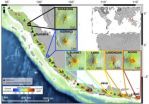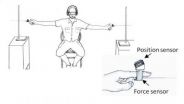Study: New tool helps doctors predict heart attack patients at risk for repeat hospitalization
Evidence-based tool at Intermountain Medical Center provides a standard approach to assessing the likelihood that a heart attack patient will end up back in the hospital
2012-11-05
(Press-News.org) SALT LAKE CITY – Some heart attack patients end up back in the hospital just weeks after going home. It can happen for a variety of reasons, but doctors haven't had a reliable way to predict which patients will return — until now.
Thanks to a new tool developed by researchers at the Intermountain Medical Center Heart Institute in Salt Lake City, physicians now have a tool to help identify these patients. This will enable physicians to re-evaluate their treatment plans in the hopes of preventing future admissions.
"If you can identify these patients, you have a better chance of saving their lives,"
said Benjamin Horne, PhD, director of cardiovascular and genetic epidemiology at the Intermountain Medical Center Heart Institute and lead researcher for the study, which will be presented Nov. 5 at the American Heart Association Scientific Sessions 2012 in Los Angeles.
Preventing hospital readmission among heart attack patients is also a key goal outlined in the Affordable Care Act. Improving the personalization of medical care during an initial hospitalization is the most effective approach to preventing repeat visits to the hospital, but until now the medical evidence regarding who will return has been very limited. This new evidence-based tool provides a standard approach to assessing the likelihood that a heart attack patient will end up back in the hospital, allowing medical providers to re-evaluate their care plan.
Dr. Horne and his group at Intermountain Medical Center looked at 51 factors including age, gender, common blood test information, other health problems, a history of depression, body mass index and more. All this information is then complied by the new tool — a sophisticated computerized algorithm — that calculates a risk score for each patient.
This is how the score works:
Men are assigned a score between zero and 13. For each additional point on the scale, men have a 20 percent greater risk of re-hospitalization. So, for example, a man with a score of 13 would be 3.6 times more likely to return to the hospital than a man with a score of zero.
Women are assigned a score between zero and 14. For each additional point on the scale, women have a 14 percent greater risk of having to return to the hospital. A woman with a score of 14 would be about 3 times more likely to be back than a woman who scored a zero.
Researchers said the factors that contributed the most information about re-hospitalization included patient age, the number of medications a patient was prescribed, the length of hospital stay when they had their heart attack, a diagnosis of depression, and a diagnosis of atrial fibrillation.
"There's a saying in medicine: You manage what you measure," said Dr. Horne. "Right now no one has a way to accurately measure the information that these risk factors tell us about readmission and mortality risk. Our tool gives physicians a way to measure their patients' risk and possibly manage their care differently."
###
The Intermountain Medical Center Heart Institute is one of the premier cardiac centers in the country.
Other members of the research team include: Brent Muhlestein; Heidi May; Kim Brunisholz; Tami L. Bair; and Jeffrey L. Anderson.
END
ELSE PRESS RELEASES FROM THIS DATE:
2012-11-05
CHICAGO – Even in men and women with an optimal cardiovascular disease (CVD) risk factor profile, the lifetime risk estimate for CVD is greater than 30 percent, and is more than 50 percent for men and women overall, according to a study appearing in November 7 issue of JAMA, a theme issue on cardiovascular disease. The study is being released early online to coincide with the American Heart Association's Scientific Sessions.
"To date, there have been no published data on the lifetime risk for total CVD (including coronary heart disease [CHD], atherosclerotic and hemorrhagic ...
2012-11-05
CHICAGO – In a randomized study that included nearly 15,000 male physicians who were middle-aged or older, daily multivitamin use for more than 10 years of treatment and follow-up did not result in a reduction of major cardiovascular events, heart attack, stroke, or death from cardiovascular disease, according to a study appearing in November 7 issue of JAMA, a theme issue on cardiovascular disease. The study is being released early online to coincide with its presentation at the American Heart Association's Scientific Sessions.
"Despite uncertainty regarding the long-term ...
2012-11-05
CHICAGO – In an examination of the incidence of coronary heart disease (CHD) in the U.S. by race and sex, black men and women had twice the rate of fatal CHD compared with white men and women, with this increased risk associated with a greater prevalence of CHD risk factors, according to a study appearing in November 7 issue of JAMA, a theme issue on cardiovascular disease. The study is being released early online to coincide with the American Heart Association's Scientific Sessions.
"Although mortality rates for acute myocardial infarction [MI; heart attack] and coronary ...
2012-11-05
CHICAGO – In a study that involved more than 16,000 Hispanic/Latino men and women living in the United States, the prevalence of major cardiovascular disease (CVD) risk factors was high and varied markedly across different background groups; and those born in the U.S. were more likely to report a history of coronary heart disease and stroke and to have multiple CVD risk factors, according to a study appearing in November 7 issue of JAMA, a theme issue on cardiovascular disease. The study is being released early online to coincide with the American Heart Association's Scientific ...
2012-11-05
MIAMI – November 5, 2012 -- A new study by scientists at the University of Miami (UM) Rosenstiel School of Marine & Atmospheric Science uses Interferometric Synthetic Aperture Radar (InSAR) data to investigate deformation prior to the eruption of active volcanoes in Indonesia's west Sunda arc. Led by geophysicist Estelle Chaussard and UM Professor Falk Amelung, the study uncovered evidence that several volcanoes did in fact 'inflate' prior to eruptions due to the rise of magma. The fact that such deformation could be detected by satellite is a major step forward in volcanology; ...
2012-11-05
Boulder, CO, USA – In communities across the U.S., people are hearing more and more about a controversial oil and gas extraction technique called hydraulic fracturing – aka, hydro-fracking. Controversies pivot on some basic questions: Can hydro-fracking contaminate domestic wells? Does it cause earthquakes? How can we know? What can be done about these things if they are true? A wide range of researchers will address these and related critical questions at the GSA Annual Meeting this week.
"When people talk about contamination from hydraulic fracturing, for instance, ...
2012-11-05
Boulder, CO, USA – Not very long ago a professional geologist's field kit consisted of a Brunton compass, rock hammer, magnifying glass, and field notebook. No longer. In the field and in the labs and classrooms, studying Earth has undergone an explosive change in recent years, fueled by technological leaps in handheld digital devices, especially tablet computers and cameras.
Geologist Terry Pavlis' digital epiphany came almost 20 years ago when he was in a museum looking at a 19th-century geology exhibit that included a Brunton compass. "Holy moly!" he remembers thinking, ...
2012-11-05
Rats use a sense that humans don't: whisking. They move their facial whiskers back and forth about eight times a second to locate objects in their environment. Could humans acquire this sense? And if they can, what could understanding the process of adapting to new sensory input tell us about how humans normally sense? At the Weizmann Institute, researchers explored these questions by attaching plastic "whiskers" to the fingers of blindfolded volunteers and asking them to carry out a location task. The findings, which recently appeared in the Journal of Neuroscience, have ...
2012-11-05
Autosomal-dominant polycystic kidney disease (ADPKD) is one of the most common genetic disorders, affecting one in every 1,000 people and responsible for up to ten percent of patients on dialysis worldwide. The disease is characterized by the development of cysts that lead to progressive kidney failure and necessitate dialysis or a kidney transplant in most patients aged around fifty. Moreover, the persistent cyst growth causes high blood pressure and painful complications. Although we have known about the disease for over a century and its genetic basis for almost 20 years, ...
2012-11-05
Hispanics and Latinos living in the U.S. are highly likely to have several major cardiovascular disease risk factors, such as high cholesterol, high blood pressure, obesity, diabetes, and smoking, according to a new, large-scale study. Risks vary among the diverse Hispanic/Latino groups, but individuals who were born in the U.S. are more likely to have multiple risk factors.
The findings are reported in the Nov. 7 issue of JAMA.
Hispanic and Latino people now comprise the largest minority group in the U.S. Although this population is relatively young, cardiovascular ...
LAST 30 PRESS RELEASES:
[Press-News.org] Study: New tool helps doctors predict heart attack patients at risk for repeat hospitalization
Evidence-based tool at Intermountain Medical Center provides a standard approach to assessing the likelihood that a heart attack patient will end up back in the hospital

